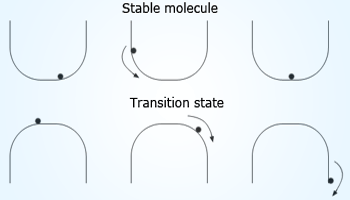 Transition State Theory of Reactivity
Transition State Theory of Reactivity is based on thermodynamic considerations.
Transition State Theory of Reactivity
Transition State Theory of Reactivity is based on thermodynamic considerations.
- All reactions proceed through the formation of an activated complex, which is having higher energy than that of the reactants and products.
- It is assumed that there is existence of equilibrium between reacting molecules and transition state.
- Rate of product formation depends on concentration of transition state or activated complex.
- The frequency at which the activated complex is converting into products.
Transition State Theory details a hypothetical transition state that exists between reactants and products during a chemical reaction.
The species formed in this hypothetical transition state is called the activated complex. The theory is used to explain how chemical reactions take place. If the rate constant has been experimentally determined, the theory can also be used to determine the standard Gibbs free energy, enthalpy, and entropy of the reaction. It is closely related to collision theory.
According to the theory, in between the state where molecules are reactants and the state where molecules are products, there is a state known as the transition state. During the transition state, the reactants are combined to form a species called the activated complex. The theory suggests that there are three major factors that determine whether a reaction will occur or not:
- The concentration of the activated complex (the species of the transition state).
- The rate at which the activated complex breaks apart
- The way in which the activated complex breaks apart: whether it breaks apart to reform the reactants or whether it breaks apart to form a new complex, the products.
Collision theory proposes that not all reactants that combine undergo a reaction. However, assuming the stipulations of the collision theory are met and a successful collision occurs between the molecules, the Transition State Theory allows for one of two outcomes: a return to the reactants, or a rearranging of bonds to form the products.